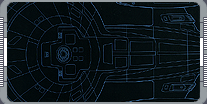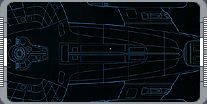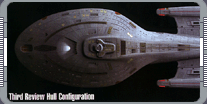
Intrepid-class Design Linage - By Rick Sternbach.
Notice: The data displayed in this library retrieval session is authorized for viewing under Starfleet
Intelligence Regulation INTEC-34-5G for personnel holding a security rating of Class A7 and above, including
but not limited to science and engineering directorates. Under special circumstances the data display may be
terminated by manual or computer control, or the data may be altered by Starfleet Intelligence in order to
confound and confuse agents of threat forces within and without the United Federation of Planets.
 By most accounts, the Galaxy class was in the final stages of development, but, even as
Starfleet pressed for large multi-mission flagships, the need for smaller vessels was becoming apparent. While
the USS Galaxy NX-70637, USS Yamato NCC-71807, and the
USS Enterprise NCC-1701-D underwent final systems installations
and testing, Admiral Imagawa spoke of the need for many different types of starships, shuttles, and support
facilities to meet the growing number of crisis points in the galaxy. Among the ship types outlined in
preliminary Starfleet requirement briefs was a fast, powerful, 'troubleshooter' vessel, initially listed as
Planform SV-65. This ship concept, created in basic form by the combined structures groups from
Earth Station McKinley and the Utopia Planitia Yards,
would need to maintain a low-cruise warp factor of 7.75 for 16 days, a high-cruise warp of 9.25 for 2.25 days,
and a dash-cruise speed of warp 9.975 for 12.65 hours. It would support a crew of 223, would have swappable
interior pressurized modules, and would mount defensive weaponry at least equal to the Galaxy-class phasers and
photon torpedoes. A wide variety of primary mission types for the new ship - from threat-force point
interception and large battle group support to covert intelligence gathering - was pared down to space defensive
combat to protect Starfleet and Federation assets, and continued scientific exploration during patrol intervals
(C. Forrester, ASDB Journal 05Nov2361).
By most accounts, the Galaxy class was in the final stages of development, but, even as
Starfleet pressed for large multi-mission flagships, the need for smaller vessels was becoming apparent. While
the USS Galaxy NX-70637, USS Yamato NCC-71807, and the
USS Enterprise NCC-1701-D underwent final systems installations
and testing, Admiral Imagawa spoke of the need for many different types of starships, shuttles, and support
facilities to meet the growing number of crisis points in the galaxy. Among the ship types outlined in
preliminary Starfleet requirement briefs was a fast, powerful, 'troubleshooter' vessel, initially listed as
Planform SV-65. This ship concept, created in basic form by the combined structures groups from
Earth Station McKinley and the Utopia Planitia Yards,
would need to maintain a low-cruise warp factor of 7.75 for 16 days, a high-cruise warp of 9.25 for 2.25 days,
and a dash-cruise speed of warp 9.975 for 12.65 hours. It would support a crew of 223, would have swappable
interior pressurized modules, and would mount defensive weaponry at least equal to the Galaxy-class phasers and
photon torpedoes. A wide variety of primary mission types for the new ship - from threat-force point
interception and large battle group support to covert intelligence gathering - was pared down to space defensive
combat to protect Starfleet and Federation assets, and continued scientific exploration during patrol intervals
(C. Forrester, ASDB Journal 05Nov2361).
 The hull configuration adopted the saucer-type shape of previous starship classes, that of primary hull,
engineering hull, and nacelles, driven by the well-understood physics of warp field generation and control.
Contributing factors included available shell and framework alloys - tritanium and duranium - plus warp reactor
and dilithium crystal morphology, deuterium and anti-matter tankage, shuttlecraft capacity, and impulse reactor
size reductions. Materials processing, fabrication techniques, and vessel maintenance cycles were evolved
directly from those applied to the Excelsior,
Ambassador, and Galaxy classes. By Stardate 38956.00, eight
computer warp stress and volumetric studies yielded the first review configuration, SV-65H. This vessel
featured a 61º elliptical saucer section integrated with the engineering hull, fixed pylons and nacelles, and a
large ejectable bridge module to augment the standard lifeboats. No saucer separation capability was required.
On January 1, 2362, the SV-65 program was officially titled the Intrepid Class Project. Continued studies of
warp fields and their interaction with the space and subspace enviroments led to six futher planform
modifications, with data on hull volumetrics, interior volume usage, and simulated warp and impulse performance
being analyzed by the Advanced Starship Design Bureau (ASDB) for optimal mission efficiency. By the end of 2363,
additional performance data from the USS Enterprise and USS Yamato shakedown flights had been incorporated into
the Intrepid warp propulsion simulations.
The hull configuration adopted the saucer-type shape of previous starship classes, that of primary hull,
engineering hull, and nacelles, driven by the well-understood physics of warp field generation and control.
Contributing factors included available shell and framework alloys - tritanium and duranium - plus warp reactor
and dilithium crystal morphology, deuterium and anti-matter tankage, shuttlecraft capacity, and impulse reactor
size reductions. Materials processing, fabrication techniques, and vessel maintenance cycles were evolved
directly from those applied to the Excelsior,
Ambassador, and Galaxy classes. By Stardate 38956.00, eight
computer warp stress and volumetric studies yielded the first review configuration, SV-65H. This vessel
featured a 61º elliptical saucer section integrated with the engineering hull, fixed pylons and nacelles, and a
large ejectable bridge module to augment the standard lifeboats. No saucer separation capability was required.
On January 1, 2362, the SV-65 program was officially titled the Intrepid Class Project. Continued studies of
warp fields and their interaction with the space and subspace enviroments led to six futher planform
modifications, with data on hull volumetrics, interior volume usage, and simulated warp and impulse performance
being analyzed by the Advanced Starship Design Bureau (ASDB) for optimal mission efficiency. By the end of 2363,
additional performance data from the USS Enterprise and USS Yamato shakedown flights had been incorporated into
the Intrepid warp propulsion simulations.
In August 2364, an improved flight performance and mass-reduction plan was implemented, dropping the Intrepid
design from 838000 to 790000 metric tons. The move required a change in warp reactor type from a heavier
centralized dilithium focus chamber to a dilithium-lined swirl chamber. This design of reactor had originally
been applied to the Constitution-class starships, and the return to the swirl chamber afforded Starfleet
engineers an opportunity to increase the structural integrity and power output. The reactor's magnetic
constrictors, matter and antimatter injectors, and plasma transfer conduits (PTCs) were designed to be assembled
by computer-controlled formers and gamma-welders. The complete warp core was designed from the outset to be
 ejectable in case of emergency. Components for a second core were stored within the engineering hell, though
assembly and flight testing by a crew in deep space could take up to a week.
ejectable in case of emergency. Components for a second core were stored within the engineering hell, though
assembly and flight testing by a crew in deep space could take up to a week.
The second review hull configuration was completed in February 2366. Warp field stresses and space enviroment
concerns led to a more streamlined primary hull and nacelles which were designed to reduce interstellar drag.
Advances in warp plasma containment and transport allowed for a hinged pylon. This modification was intended to
give the ship a better warp factor-to-reactant usage ratio. It later emerged that it had the fortunate
by-product of eliminating the kind of spatial damage caused by earlier designs of warp engine that had been
uncovered by Drs. Rabal and Serova in 2369 (Rabal, Journal of Warp Dynamics Vol. 1137). Other changes from the
first review hull included smaller warp coil sets, larger shuttlebay capacity, crew reduction to 168, smaller
Deck 1 module, and increased internal space for laboratories, storage, and consumables. The forward
auxiliary deflector remained in the second review hull, though warp and impulse performance data suggested that
a thinner, edge-mounted unit might have reduced the Particles and Fields Drag Index (PFDI) from 0.0033 to
0.0014. The larger figure was withing tolerances and the deflector was integrated into the hull with minor
rerouting of EPS and ODN conduits and associated controller hardware.
The third design review froze the Intrepid configuration in October 2367, with initial fabrication orders for
seven vessels. Computer, human, and cetacean analysis teams recommended changes to the primary hull on the
forward edge, Deck 2 surface contours, and aft attachment blends to the engineering hull, all as a result of
warp efficiency simulations. Structures and systems that were not fully integrated by the third review were
accepted as yard changes, and upgrades would be applied to each ship as it was constructed. Final systems
improvements designed and approved for installation by April 2368 included phasers, lifeboats, RCS thruster
quads, gravity generators, Multi-directional Sensor Array (MSA), and the AeroShuttle. Vessel Frame IC-103,
USS Voyager NCC-74656, was the first ship to receive all updated hardware
as original installations, after testbed results were gathered from its two older Spacedock siblings (P. Bryce,
Starfleet Construction Proceedings, Data Index RI-456/32/456).
It is interesting to note that defensive weapons deployments on the Intrepid pathfinder design fluctuated over a
wide range of types and numbers of devices, as Starfleet planners wrestled with decisions over mission types,
time between starbase resupply opportunities, and suitability of particular weapons classes to available power
 systems and launcer hardware. Five phaser emitters - two dorsal, two ventral, one ventral lower - and two
forward photon torpedo launchers grew to 13 phaser emitters - adding two dorsal aft, two ventral aft, two pylon,
two dorsal fantail - and four torpedo launchers. The additional aft-firing tubes and increased phaser coverage
insured that the Intrepid class could counter most known and predicted threat vessels of similar size and mass,
in battle group, escorted, or solitary operation scenarios. Lifeboats were enlarged slightly to accommodate six
crew, up from the original four. The relatively small volume lost within the starship would also be used to
give each lifeboat an operating lifetime of almost 16 months, and a total impulse range of 0.25 light years.
Jettisonable hatches were replaced with hinged covers in the event that shipboard emergencies were averted
following pod launch. Improved communications and life-support systems could be shared through the docking of
multiple lifeboats in 'gaggle mode,' first proven in the Galaxy class.
systems and launcer hardware. Five phaser emitters - two dorsal, two ventral, one ventral lower - and two
forward photon torpedo launchers grew to 13 phaser emitters - adding two dorsal aft, two ventral aft, two pylon,
two dorsal fantail - and four torpedo launchers. The additional aft-firing tubes and increased phaser coverage
insured that the Intrepid class could counter most known and predicted threat vessels of similar size and mass,
in battle group, escorted, or solitary operation scenarios. Lifeboats were enlarged slightly to accommodate six
crew, up from the original four. The relatively small volume lost within the starship would also be used to
give each lifeboat an operating lifetime of almost 16 months, and a total impulse range of 0.25 light years.
Jettisonable hatches were replaced with hinged covers in the event that shipboard emergencies were averted
following pod launch. Improved communications and life-support systems could be shared through the docking of
multiple lifeboats in 'gaggle mode,' first proven in the Galaxy class.
The RCS maneuvering thrusters and gravity generators shared key electro-plasma system (EPS) technology for both
the production and distribution of high-energy plasma. The RCS microfusion reactors and thruster nozzle relied
on redunant sets of magnetic valves and polished felnium tritonide conduits to precisely rotate Voyager, and
drive it at low velocities. These same conduits and valves were designed into the new gravity plating, a
carpet of thousands of miniaturized graviton generators, each measuring 3.23 cm across. The hexagonal valves
responded to plasma pressure variations, averaging out power distribution, and allowing for up to 10 percent
generator failure without a perceptible change in local gravity. In earlier starships, larger and fewer
graviton devices had occasionally produced unpleasant balance and minor nausea effects, particularly in rookie
crew members.
The MSA was actually 14 separate arrays that were synchronized with dedicated optical data network (ODN)
connections, the main and auxiliary computer cores and processing commands that synthesized a total view of the
space enviroment 6500 times per second. The MSA, while short range, working in concert with the navigational
deflector and long-range sensor instruments. The AeroShuttle was the only upgraded component to the Intrepid
class that remained in the development cycle long after the other major systems had been frozen and released for
fabrication and assembly. Based on the existing Starfleet runabout planform, the AeroShuttle was given a 450
percent increase in atmospheric flight and hover endurance over standard shuttlecraft. This was accomplished
through the use of hybrid microfusion and EM driven airflow coil engines. Although the AeroShuttle spaceframe
and basic systems were completed by Stardate 46875.3, final outfitting of mission-specific hardware was delayed
until simulations and flight testing with the USS Intrepid could be completed. All seven Intrepid-class
starships in the initial procurement were constructed at the Utopia Planitia Yards in Mars orbit, minus their
 active and backup warp cores, and also lacking their final outer surface plating and distinctive coloration.
Each vessel crossed the distance from Mars to Earth Station McKinley Spacedock under low impulse, recording
systems performance data on the way.
active and backup warp cores, and also lacking their final outer surface plating and distinctive coloration.
Each vessel crossed the distance from Mars to Earth Station McKinley Spacedock under low impulse, recording
systems performance data on the way.
Voyager's core installtion took place on Stardate 47834.6, fast-tracked to follow Intrepid and Bellerophon by
only three months. With assembly and internal systems checks completed, the official launching ceremony of the
USS Voyager occurred at McKinley on Stardate 48038.5 (January 14, 2371) at 1222 hours GMT. A 15-day series of
impulse tests, which verified the integrity of the vessel and systems operation at sub-light velocities,
culminated in Voyager accelerating to Warp 1.03 with the USS Hauck flying formation for engineering support and
emergency backup. Three weeks of warp flight tests added to the Intrepid class knowledge base and insured that
Voyager's computer cores and bio-neural gel packs could receive operational programming loads for deployment in
the Alpha Quadrant. USS Voyager, under the command of Captain Kathryn Janeway, received her first patrol
assignment on Stardate 48183.5. All inflight systems data continued to be transmitted to Stafleet Command for
evaluation, along a range of velocities from inertial stop to Warp 9.986 and for distances up to 45 light years,
with subspace com relays handling the encrypted telemetry loop. Subsequent operational missions validated
upgrades from previous Starfleet vessels. Voyager would provide only a few months of usable data before its
disappearance in the Delta Quadrant. However, the stored information and lessons learned by its crew proved
invaluable upon her return, a testament to the designers and engineers who stood upon the shoulders of giants to
build her.
|
|
"INTREPID CLASS DESIGN LINAGE" - MAY 2002 ISSUE 37 STAR TREK: THE MAGAZINE COPYRIGHT OF PARAMOUNT PICTURES.
|